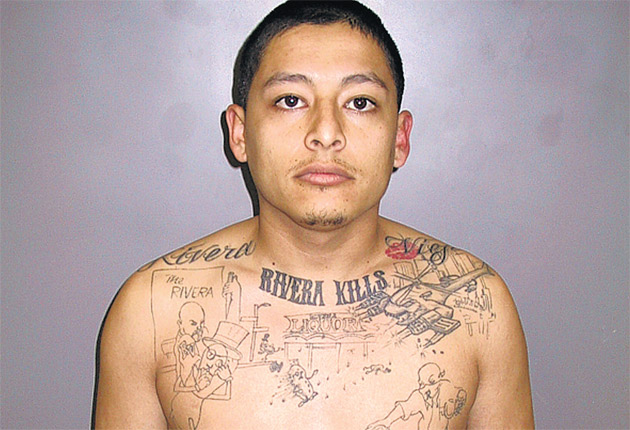Inked Red Handed

The image above — you can see a slightly larger version here — shows a man named Anthony Garcia, with an intended focus (not that you could miss it) on his very detailed tattoo. The tattoo (here’s a zoomed-in version) depicts a murder scene — the words “Rivera Kills” positioned prominently may have given that away — which makes for an unusual choice for body art.
In this case, the tattoo depicts a murder that Garcia had a hand in. “Rivera” is a reference to Rivera-13, the gang Garcia was a member of at the time. The large, guns-blazing helicopter on his left shoulder is reference to his nickname, “Chopper.” The liquor store’s image is a close approximation of the one from crime scene — even the street lights are shaped properly. There’s a peanut riddled with bullets and “peanut” is a slang term for a member of a rival gang. And just to put a button on it, the liquor store is shown with Christmas lights hanging from its roof. On the day of the murder, January 23, 2004, the actual liquor store featured the same decoration.
Garcia is currently in prison for committing this murder, and while rare, it’s not unheard of for inmates to ink themselves with the good and the bad of their lives’ details. But that’s not what happened here. In most cases, incriminating tattoos come after you’re convicted. In this case, Garcia’s came before he was even arrested. In fact, it’s what landed him in prison.
The January 23, 2004 murder of 23-year-old John Juarez went unsolved for nearly a decade. But in that interim period, Anthony Garcia committed a few other crimes — petty ones, in this case. He was a graffiti artist, tagging buildings here and there. He’d been picked up a few times for vandalism and, as the Los Angeles Times explained, this yielded some interesting photos:
Before they are released, suspected gang members typically are asked to remove their shirts and have their tattoos photographed by graffiti team deputies. Taggers often mark their own bodies with the same signatures they spray on buses and storefronts — and eyewitnesses to crimes sometimes help close cases by recalling distinctive tattoos.
But usually, it doesn’t go much further than that. But this case was as unusual as Garcia’s tattoo.
In 2011 — seven years after Juarez’s murder — a homicide detective named Kevin Lloyd was flipping through photos of gang members and their tattoos and came across the one shown above. Coincidentally, Lloyd was one of the officers who, seven years earlier, investigated the crime scene of the case described above. Garcia’s tattoos were familiar enough to Lloyd that he requested the old case file and, after further inspection, Lloyd could safely say he had found a match. Garcia was arrested and, during an in-cell sting operation, “bragged about the shooting,” per the Times.
Garcia was sentenced to a 65-year prison sentence in May of 2011.
Bonus Fact: Many professional athletes also have various tattoos, but notably, soccer superstar Cristiano Ronaldo doesn’t. The Portuguese national team captain forgoes the ink so that he can donate blood often, as Yahoo News reported: “In many countries, a new tattoo can affect how often a person donates blood, with a waiting period between six months and a year employed as a precaution against cross-contamination and diseases like hepatitis.”
From the Archives: On the Juice: Invisible ink and a criminal. Kind of.
Related: “Pen and Ink: Tattoos and the Stories Behind Them” by Isaac Fitzgerald and Wendy MacNaughton. 4.3 stars on 36 reviews.
